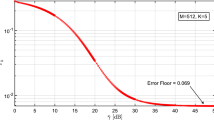Abstract
This paper exploits variations in the average channel gains in multi-cell multi-user massive multiple input multiple output (MIMO) systems. An average transmit power-control-based sum-rate optimization scheme is presented for the uplink of the system. The matched filtering (MF) and the zero forcing (ZF) processors are considered with perfect and imperfect channel state information at receiver (CSIR) under frequency flat Rayleigh fading channel. An average power-control-based system model is constructed for analyzing the sum-rate and formulating an optimization problem. A discrete level combinatorial optimization is performed for MF and ZF sum-rate under perfect and imperfect CSIR. The numerical results show a significant improvement in the sum-rate and power consumption. A low complexity algorithm for numerical optimization of the sum-rate is proposed. The performance of algorithm is quantified with different scenarios including different number of users, macro cells, and micro cells with low and high inter-cell interference powers. The evaluation results show that the improvement in sum-rate and energy efficiency increases with inter-cell interference power and the number of MTs.





Similar content being viewed by others
References
Marzetta TL (2010) Noncooperative cellular wireless with unlimited numbers of base station antennas. IEEE Trans Wirel Commun 9(11):3590–3600
Lu L et al (2014) An overview of massive MIMO: Benefits and challenges. IEEE J Sel Topics Signal Process 8(5):742–758
Larsson EG, Edfors O, Tufvesson F, Marzetta TL (2014) Massive MIMO for next generation wireless systems. IEEE Commun Mag 52(2):186–195
Björnson E, Larsson EG, Marzetta TL (2016) Massive MIMO: ten myths and one critical question. IEEE Commun Mag 54(2):114–123
Chockalingam A, Rajan BS (2014) Large MIMO systems. Cambridge University Press, Cambridge
Ngo HQ, Larsson EG, Marzetta TL (2013) The multicell multiuser MIMO uplink with very large antenna arrays and a finite-dimensional channel. IEEE Trans Commun 61(6):2350–2361
Spencer QH, Peel CB, Swindlehurst AL, Haardt M (2004) An introduction to the multi-user MIMO downlink. IEEE Commun Mag 42(10):60–67
de Lamare RC (2013) Massive MIMO systems: Signal processing challenges and research trends. arXiv:1310.7282
Rusek F, Persson D, Lau BK, Larsson EG, Marzetta TL, Edfors O et al (2013) Scaling up MIMO opportunities and challenges with very large arrays. IEEE Sig Process 30(1):40–60
Edelman A, Rao NR (2005) Random matrix theory. Cambridge university press, Cambridge
Tulino A, Verdu S (2004) Random matrix theory and wireless communications. Foundation and Trends in Communications and Information Theory. Now Publishers, Inc., Delft
Ngo HQ, Larsson EG, Marzetta TL (2013) Energy and spectral efficiency of very large multiuser MIMO systems. IEEE Trans Commun 61(4):1436–1449
Ngo HQ, Matthaiou M, Duong TQ, Larsson EG (2013) Uplink performance analysis of multicell MU-SIMO systems with ZF receivers. IEEE Trans Veh Technol 62(9):4471–4482
Kong C, Zhong C, Papazafeiropoulos AK, Matthaiou M, Zhang Z (2015) Sum-rate and power scaling of massive MIMO systems with channel aging. IEEE Trans Commun 63(12):4879–4893
Liu L, Matolak DW, Tao C, Li Y, Chen H (2016) Sum-rate capacity investigation of multiuser massive MIMO uplink systems in semi-correlated channels. In: Vehicular Technology Conference (VTC Spring). IEEE, Nanjing
Erceg V, Greenstein LJ, Tjandra SY, Parkoff SR, Gupta A, Kulic B et al (1999) An empirically based path loss model for wireless channels in suburban environments. IEEE J Sel Areas Commun 17(7):1205–211
Zarei S, Aulin J, Gerstacker W, Schober R (2017) Max-min multicell-aware precoding and power allocation for downlink massive MIMO systems. IEEE Sig Process Lett 24(10):1433–1437
Nayebi E, Ashikhmin A, Marzetta TL, Yang H, Rao BD (2017) Precoding and power optimization in cell-free massive MIMO systems. IEEE Trans Wirel Commun 16(7):4445–4459
Zhang J, Jiang Y, Li P, Zheng F, You X (2016) Energy efficient power allocation in massive MIMO systems based on standard interference function. In: Vehicular Technology Conference (VTC Spring). IEEE, Nanjing
Björnson E, Sanguinetti L, Hoydis J, Debbah M (2015) Optimal design of energy-efficient multi-user MIMO systems: Is massive MIMO the answer. IEEE Trans Wirel Commun 14(6):3059–3075
Nguyen TM, Ha VN, Le LB (2015) Resource allocation optimization in multi-user multi-cell massive MIMO networks considering pilot contamination. IEEE Access 3:1272– 1287
Dai Y, Dong X (2016) Power allocation for multi-pair massive MIMO two-way AF relaying with linear processing. IEEE Trans Wireless Commun 15(9):5932–5946
Li Y, Fan P, Leukhin A, Liu L (2017) On the spectral and energy efficiency of full-duplex small-cell wireless systems with massive MIMO. IEEE Trans. Veh. Technol 66(3):2339–2353
Author information
Authors and Affiliations
Corresponding author
Appendices
Appendix A
1.1 Appendix A.1
Let us find the ρ for which \(R|{~}_{\gamma _{2}= 0}=R|{~}_{\gamma _{2}= 1}\Rightarrow \log _{2}\left \{1+\frac {(N-1)\beta _{1}}{\rho } \right \}=\)
The positive root of above equation (ρ > 0) is:
The ρc is the critical value of ρ where sum-rate is same whether weak user is transmitting full power or not transmitting at all.
1.2 Appendix A.2
By setting \(\frac {d}{d\gamma _{2}}(R)= 0\) we obtain
Solving the above equation for positive γ2,
Since the γc is unique thus sum-rate has a maxima or minima at γ2 = γc. Numerical results show that for two users it is minima but for multi-user case, there exists a global maxima for 0 < γk < 1;1 ≤ k ≤ K for certain range of ρ.
Appendix B
Path loss is modeled as follows[16, eq:1-6]:
Path loss equation can be written in terms of fixed and varying components as follows:
xB, xC and yC are distributed as \(\mathbb {N}(0,1)\).
Rights and permissions
About this article
Cite this article
Dahiya, S., Kumar, A. & Singh, A.K. Average power allocation based sum-rate optimization in massive MIMO systems. Ann. Telecommun. 73, 689–701 (2018). https://doi.org/10.1007/s12243-018-0628-5
Received:
Accepted:
Published:
Issue Date:
DOI: https://doi.org/10.1007/s12243-018-0628-5




